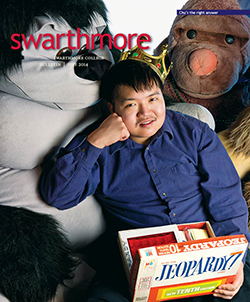Poems of Peace and More …
Swarthmore’s Quaker founders avoided alcohol and tobacco, music halls, horse racing, election campaigns, and military pageants. What was left? Nature and science, particularly botany. When the Friends’ Social Lyceum visited the campus soon after the College was chartered in 1864, the outing included rambles on the grounds and strolls along Crum Creek. The children amused themselves by playing ball and jumping rope. The afternoon lyceum program included recitations and original poems, lectures on science, and expositions on Quaker history.
These included a lecture on “The influence of cell-tissue on animal and vegetable life” by T.C. Taylor; a paper titled “Is the theory of Professor Esby, in regard to the production of rain, by combustion, sustained by the facts?” by Thomas Walter; and a contribution by T. Clarkson Clothier, “Did William Penn occupy the house at 2nd Street and Norris’ Alley?” A previous column quoted from a poem composed by Ann Preston, dean of the Philadelphia Female Medical School.
The year of Swarthmore’s founding, 1864, would be the bloodiest year of the American Civil War. In a poetical contribution, Susanna Maxfield Parrish hoped for a time that war would be as extinct as the mastodon:
And let us build a temple here,
Sacred to peace and love;
The warlike eagle must not be
Its emblem, but the dove.
We may not found a Prophet’s School,
But we may plan for one,
When the rapt prophet’s dream of peace
May haply be begun.
Susanna Parrish was the sister-in-law of Edward Parrish, married to Edward’s elder brother Dillwyn, longtime president of the Pennsylvania Abolition Society. Her grandson, Maxfield Parrish, became a well-known and very successful illustrator and artist.
Swarthmore College has what is arguably the oldest peace studies program in the United States. Perhaps peace studies goes back to the founding of the College—and Parrish’s poem. The College certainly continues its founders’ interest in peace. As far as an emblem goes, we have not the dove but a Phoenix.
—Christopher Densmore, curator, Friends Historical Library
 Email This Page
Email This Page